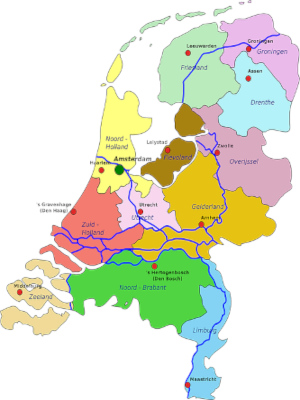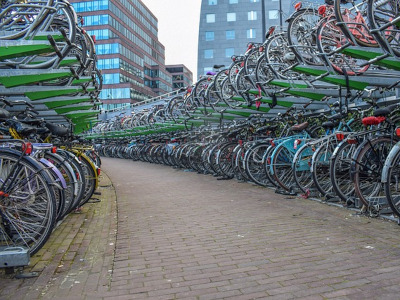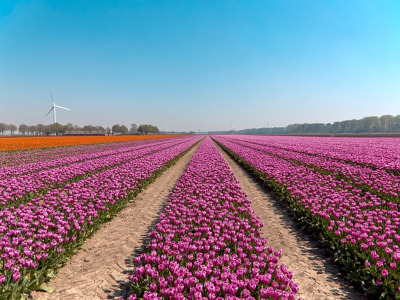Whether you are living in the Netherlands or simply paying a visit, acquainting yourself with some intriguing information about the country will enhance your understanding of it. This article contains 10 facts about the Netherlands.
Holland and the Netherlands are not the same thing.
The distinction between ‘the Netherlands’ and ‘Holland’ often confuses people when referring to the country. It is important to note that the Netherlands is divided into 12 provinces, while Holland specifically refers to two provinces: North Holland (Noord Holland) and South Holland (Zuid Holland). Historically, Holland played a significant role in the Dutch kingdom’s economy and prosperity, leading to its common usage as a name for the entire country, although used incorrectly. However, as of January 2020, the Dutch government officially dropped the nickname ‘Holland’ and now exclusively identifies itself as the Netherlands, aiming to enhance its international image.
The Netherlands is the lowest-lying country in Europe.
More than a quarter of the country is actually below sea level. Additionally, about 60% of the population resides 5 meters below sea level. The highest point in the Netherlands is a hill in Vaalserberg, reaching 322.5m above sea level. On the other hand, the lowest point is Zuidplaspolder, which is 7 meters below sea level. Fortunately, the Dutch have clever methods such as windmills, pumping stations, polders, and dikes to keep the land dry.
The Netherlands is the sixth-happiest country in the world.
The Netherlands has been ranked as the sixth-happiest country in the world, according to the 2020 World Happiness Report. This annual study considers various factors, including healthy life expectancy, freedom, trust, corruption, and social support, to determine the rankings. The Dutch people have a lot to be grateful for, as they scored high in social and institutional trust as well as social connection. Interestingly, they also ranked higher than their neighboring countries, Germany (17th) and Belgium (20th). The report states that only Finland, Denmark, Switzerland, Iceland, and Norway are happier nations.
The Dutch are very healthy.
The Dutch have the healthiest diet in the world. They are ranked number one in the Oxfam Food Index for having abundant, nutritious, and affordable food. Despite their love for indulgent snacks, the Dutch still prioritize eating their greens. This is not surprising considering that the Netherlands is a major exporter of vegetables. Additionally, the Dutch have the most physically active population in Europe. Around 56% of them engage in sports on a weekly basis, thanks to the country’s excellent infrastructure for walking and cycling. Speaking of cycling, there are more bicycles in the Netherlands than people. With over 22 million bikes, it’s no wonder that cycling is a popular mode of transportation.
The Dutch invented numerous things.
The Dutch were the first to create the world’s initial stock market. In 1602, Dutch legislators and businessmen established the Amsterdam Stock Exchange to fund the Dutch East India Company’s trade voyages. They also introduced Fairtrade certification with the Max Havelaar certificate in the 1980s. Furthermore, the Dutch company Philips is responsible for inventing CDs, DVDs, and Blu-ray. They started with the cassette in 1963 and later collaborated with Sony to introduce the CD. In 1997, Philips created the DVD as a replacement for VHS, which eventually led to the development of Blu-ray. Additionally, Philips played a significant role in popularizing various home electronics in Europe, including TVs and blenders.
The Netherlands is the best in the world when it comes to speaking English.
Dutch is the official language, but English is widely spoken. According to the EF English Proficiency Index, the Dutch are the top English speakers, just ahead of Denmark and Sweden. Between 90 and 93% of the population can speak English as a second language. Not only that, but about 94% of Dutch people can speak two languages, which is much higher than the EU average of 54%.
One-fifth of the Duch population is foreign-born.
Over 3 million residents have a non-Dutch background, with more than half of them coming from non-Western countries including Turkey, Surinam, Morocco, the Antilles, and Aruba. In cities such as Amsterdam and Rotterdam, nearly one-third of the population is of non-Western origin. This cultural diversity brings a variety of delicious ethnic foods to major Dutch cities.
Tulips are not originally from the Netherlands.
Tulips were imported from Turkey in the 16th century. Despite this, tulips have become an important part of Dutch culture. They celebrate National Tulip Day every third Saturday in January, marking the start of the tulip season, with free flower picking and flower festivals. The Netherlands is the world’s leading exporter of flowers, with almost 80% of the world’s flower bulbs coming from there. Most of these flowers are tulips. Each year, around two billion tulips are exported from the Netherlands to various destinations around the world. Additionally, the Keukenhof Gardens is a popular destination in the Netherlands as it is known for its breathtaking display of tulips.
Orange is the national color of the Netherlands.
The Netherlands has orange as its national color, even though their flag is red, white, and blue. This is because the monarchy is from the House of Orange, and the current king, Willem-Alexander, was the Prince of Orange before becoming king. To show their pride, the Dutch wear orange on special days, and their sports teams wear orange uniforms. The Dutch also played a role in making carrots orange. In the past, carrots were mostly yellow, white, or purple. However, in the 17th century, Dutch growers cultivated orange carrots as a tribute to William of Orange, who fought for Dutch independence. The orange color became popular, and the original carrot species were eventually replaced.
It is quite common for babies to be born at home in the Netherlands.
Approximately one in eight babies are born at home, which is one of the highest rates in developed countries. However, the number of home births has decreased since the 1990s. In 2017, only 13% of women chose to give birth at home, compared to 35% in the past. This decline is believed to be due to the increasing demand for pain relief that cannot be provided at home. Nevertheless, Dutch health insurance still covers home births.
Sources:
https://www.expatica.com/nl/moving/about/netherlands-facts-108857/



